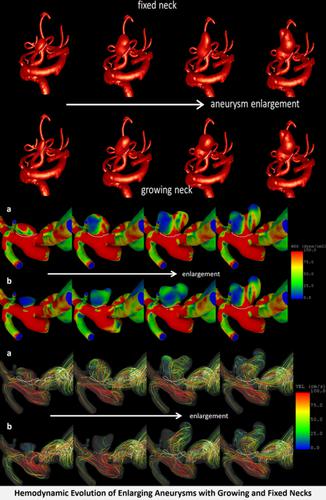当前位置:
X-MOL 学术
›
Int. J. Numer. Method. Biomed. Eng.
›
论文详情
Our official English website, www.x-mol.net, welcomes your feedback! (Note: you will need to create a separate account there.)
Analysis of hemodynamic changes from aneurysm inception to large sizes
International Journal for Numerical Methods in Biomedical Engineering ( IF 2.1 ) Pub Date : 2020-11-18 , DOI: 10.1002/cnm.3415 Seyedeh Fatemeh Salimi Ashkezari 1 , Fernando Mut 1 , Bong Jae Chung 2 , Anne M Robertson 3, 4 , Juhana Frösen 5 , Juan R Cebral 1
International Journal for Numerical Methods in Biomedical Engineering ( IF 2.1 ) Pub Date : 2020-11-18 , DOI: 10.1002/cnm.3415 Seyedeh Fatemeh Salimi Ashkezari 1 , Fernando Mut 1 , Bong Jae Chung 2 , Anne M Robertson 3, 4 , Juhana Frösen 5 , Juan R Cebral 1
Affiliation

|
While previous studies have identified many risk factors for the progression and rupture of cerebral aneurysms, the changes in aneurysm flow characteristics during its evolution are not fully understood. This work analyzes the changes in the aneurysm hemodynamic environment from its initial development to later stages when the aneurysm has substantially enlarged. A total of 88 aneurysms at four locations were studied with image based computational fluid dynamics (CFD). Two synthetic sequences representing the aneurysm geometry at three earlier stages were generated by shrinking the aneurysm sac while keeping the neck fixed or shrinking the neck simultaneously. The flow conditions were then quantitatively compared between these two modes of evolution. As aneurysms enlarged, the inflow rate increased in growing neck sequences, but decreased in fixed neck sequences. The inflow jet became more concentrated in both sequences. The mean aneurysm flow velocity and wall shear stress decreased in both sequences, but they decreased faster in enlarging aneurysms if the neck was fixed. Additionally, the intra‐aneurysmal flows became more complex and more unstable, wall shear stress distribution became more oscillatory, and the area under low wall shear stress increased for both sequences. The evolution of flow characteristics of aneurysms with fixed and growing necks are different. The observed trends suggest that fixed neck aneurysms may evolve towards a flow environment characteristic of stable aneurysms faster than aneurysms with growing necks, which could also evolve towards a more disfavorable environment.
中文翻译:

从动脉瘤开始到大尺寸的血流动力学变化分析
虽然以前的研究已经确定了脑动脉瘤进展和破裂的许多危险因素,但动脉瘤在其演变过程中流动特征的变化尚不完全清楚。这项工作分析了动脉瘤血流动力学环境从其初始发展到动脉瘤已显着扩大的后期阶段的变化。使用基于图像的计算流体动力学 (CFD) 研究了四个位置的总共 88 个动脉瘤。通过收缩动脉瘤囊同时保持颈部固定或同时收缩颈部来生成代表三个早期阶段的动脉瘤几何形状的两个合成序列。然后对这两种演化模式之间的流动条件进行定量比较。随着动脉瘤的扩大,流入速度在不断增长的颈部序列中增加,但在固定颈部序列中减少。流入射流在两个序列中变得更加集中。两个序列的平均动脉瘤流速和壁切应力均下降,但如果颈部固定,则在扩大的动脉瘤中下降更快。此外,两个序列的动脉瘤内流动变得更加复杂和不稳定,壁剪应力分布变得更加振荡,并且低壁剪应力下的面积增加。颈固定和生长颈的动脉瘤血流特征的演变是不同的。观察到的趋势表明,固定颈动脉瘤可能比颈长的动脉瘤更快地向稳定动脉瘤的流动环境特征发展,这也可能向更不利的环境演变。流入射流在两个序列中变得更加集中。两个序列的平均动脉瘤流速和壁切应力均下降,但如果颈部固定,则在扩大的动脉瘤中下降更快。此外,两个序列的动脉瘤内流动变得更加复杂和不稳定,壁剪应力分布变得更加振荡,并且低壁剪应力下的面积增加。颈固定和生长颈的动脉瘤血流特征的演变是不同的。观察到的趋势表明,固定颈动脉瘤可能比颈长的动脉瘤更快地向稳定动脉瘤的流动环境特征发展,这也可能向更不利的环境演变。流入射流在两个序列中变得更加集中。两个序列的平均动脉瘤流速和壁切应力均下降,但如果颈部固定,则在扩大的动脉瘤中下降更快。此外,两个序列的动脉瘤内流动变得更加复杂和不稳定,壁剪应力分布变得更加振荡,并且低壁剪应力下的面积增加。颈固定和生长颈的动脉瘤血流特征的演变是不同的。观察到的趋势表明,固定颈动脉瘤可能比颈长的动脉瘤更快地向稳定动脉瘤的流动环境特征发展,这也可能向更不利的环境演变。但如果颈部固定,它们在扩大的动脉瘤中减少得更快。此外,两个序列的动脉瘤内流动变得更加复杂和不稳定,壁剪应力分布变得更加振荡,并且低壁剪应力下的面积增加。颈固定和生长颈的动脉瘤血流特征的演变是不同的。观察到的趋势表明,固定颈动脉瘤可能比颈长的动脉瘤更快地向稳定动脉瘤的流动环境特征发展,这也可能向更不利的环境演变。但如果颈部固定,它们在扩大的动脉瘤中减少得更快。此外,两个序列的动脉瘤内流动变得更加复杂和不稳定,壁剪应力分布变得更加振荡,并且低壁剪应力下的面积增加。颈固定和生长颈的动脉瘤血流特征的演变是不同的。观察到的趋势表明,固定颈动脉瘤可能比颈长的动脉瘤更快地向稳定动脉瘤的流动环境特征发展,这也可能向更不利的环境演变。并且两个序列的低壁剪应力下的面积都增加了。颈固定和生长颈的动脉瘤血流特征的演变是不同的。观察到的趋势表明,固定颈动脉瘤可能比颈长的动脉瘤更快地向稳定动脉瘤的流动环境特征发展,这也可能向更不利的环境演变。并且两个序列的低壁剪应力下的面积都增加了。颈固定和生长颈的动脉瘤血流特征的演变是不同的。观察到的趋势表明,固定颈动脉瘤可能比颈长的动脉瘤更快地向稳定动脉瘤的流动环境特征发展,这也可能向更不利的环境演变。
更新日期:2021-01-18
中文翻译:

从动脉瘤开始到大尺寸的血流动力学变化分析
虽然以前的研究已经确定了脑动脉瘤进展和破裂的许多危险因素,但动脉瘤在其演变过程中流动特征的变化尚不完全清楚。这项工作分析了动脉瘤血流动力学环境从其初始发展到动脉瘤已显着扩大的后期阶段的变化。使用基于图像的计算流体动力学 (CFD) 研究了四个位置的总共 88 个动脉瘤。通过收缩动脉瘤囊同时保持颈部固定或同时收缩颈部来生成代表三个早期阶段的动脉瘤几何形状的两个合成序列。然后对这两种演化模式之间的流动条件进行定量比较。随着动脉瘤的扩大,流入速度在不断增长的颈部序列中增加,但在固定颈部序列中减少。流入射流在两个序列中变得更加集中。两个序列的平均动脉瘤流速和壁切应力均下降,但如果颈部固定,则在扩大的动脉瘤中下降更快。此外,两个序列的动脉瘤内流动变得更加复杂和不稳定,壁剪应力分布变得更加振荡,并且低壁剪应力下的面积增加。颈固定和生长颈的动脉瘤血流特征的演变是不同的。观察到的趋势表明,固定颈动脉瘤可能比颈长的动脉瘤更快地向稳定动脉瘤的流动环境特征发展,这也可能向更不利的环境演变。流入射流在两个序列中变得更加集中。两个序列的平均动脉瘤流速和壁切应力均下降,但如果颈部固定,则在扩大的动脉瘤中下降更快。此外,两个序列的动脉瘤内流动变得更加复杂和不稳定,壁剪应力分布变得更加振荡,并且低壁剪应力下的面积增加。颈固定和生长颈的动脉瘤血流特征的演变是不同的。观察到的趋势表明,固定颈动脉瘤可能比颈长的动脉瘤更快地向稳定动脉瘤的流动环境特征发展,这也可能向更不利的环境演变。流入射流在两个序列中变得更加集中。两个序列的平均动脉瘤流速和壁切应力均下降,但如果颈部固定,则在扩大的动脉瘤中下降更快。此外,两个序列的动脉瘤内流动变得更加复杂和不稳定,壁剪应力分布变得更加振荡,并且低壁剪应力下的面积增加。颈固定和生长颈的动脉瘤血流特征的演变是不同的。观察到的趋势表明,固定颈动脉瘤可能比颈长的动脉瘤更快地向稳定动脉瘤的流动环境特征发展,这也可能向更不利的环境演变。但如果颈部固定,它们在扩大的动脉瘤中减少得更快。此外,两个序列的动脉瘤内流动变得更加复杂和不稳定,壁剪应力分布变得更加振荡,并且低壁剪应力下的面积增加。颈固定和生长颈的动脉瘤血流特征的演变是不同的。观察到的趋势表明,固定颈动脉瘤可能比颈长的动脉瘤更快地向稳定动脉瘤的流动环境特征发展,这也可能向更不利的环境演变。但如果颈部固定,它们在扩大的动脉瘤中减少得更快。此外,两个序列的动脉瘤内流动变得更加复杂和不稳定,壁剪应力分布变得更加振荡,并且低壁剪应力下的面积增加。颈固定和生长颈的动脉瘤血流特征的演变是不同的。观察到的趋势表明,固定颈动脉瘤可能比颈长的动脉瘤更快地向稳定动脉瘤的流动环境特征发展,这也可能向更不利的环境演变。并且两个序列的低壁剪应力下的面积都增加了。颈固定和生长颈的动脉瘤血流特征的演变是不同的。观察到的趋势表明,固定颈动脉瘤可能比颈长的动脉瘤更快地向稳定动脉瘤的流动环境特征发展,这也可能向更不利的环境演变。并且两个序列的低壁剪应力下的面积都增加了。颈固定和生长颈的动脉瘤血流特征的演变是不同的。观察到的趋势表明,固定颈动脉瘤可能比颈长的动脉瘤更快地向稳定动脉瘤的流动环境特征发展,这也可能向更不利的环境演变。



























 京公网安备 11010802027423号
京公网安备 11010802027423号